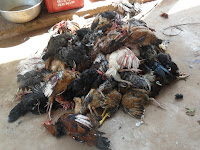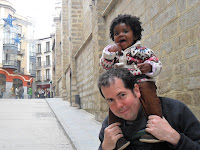 |
| The Chief |
During the holidays the Togolese and Tchekpo community do a lot of the same things we do at home. People who passed me on the roads and dropped by my house every day wished me a Bonne fette de Noel (Merry Christmas) and Nouveau Annee (Happy New Year.) I received gifts of pineapples, papaya’s, and bundles of plantains. Neighbors, new friends and people I’ve been working with here in Tchekpo sincerely thanked me for being here. They smiled, took my hand and blessed me. I felt their warmth and sincerity. I also felt their merriment of the season.
The desire to express good will during the holidays is something I happily shared with my Togolese friends. One of the things I wanted to discover for myself on this journey is, what basic traits do all humans share? Whether they live in the suburbs of mid-america, or a small village in Africa, what do we have in common? What is innate? What are we born with, and what is learned? The answer to these questions are deep, layered and multi-faceted, and would be better answered by Margaret Meade, but I try….just the same.
The Fette
 |
| The Chief praising the gods |
I made the rounds to the elders, bowed, held my elbow and shook their hands. There is always a snap of each others pointer finger at the end of the hand shake. It took me a while to master, but now I have the Togolese handshake down. I greeted most of them in their local language, Ewe (e-vah). The sodebe (local liquor) was flowing, "making spirits high." Soon after we arrived the Chief greeted me. I do like the Chief for many reasons. I think he’s intelligent, and he has a very good sense of humor. He wanted to know where my camera was. I told him I didn't bring it. He asked why. I told him I didn’t know I was coming to a party, and I offered to walk home to get it. He wanted me to, so I did. Round trip walk about 45 minutes. But I was glad to have the diversion of this task. I didn’t know why, but I wasn’t feeling particularly comfortable with the crowd or the celebration. I returned to the festivities with my camera. Without any preconceived notions of what might occur.
Not like our celebrations at home, I can tell you that. Well actually parts of it were similar. It was family and friends and their children having a party, being happy to see and visit with each other, but that may be the only similarity. This was an authentic Voodooese Fette, with all their trimmings…..they were ready to celebrate and at the same time, pay homage to their god(s)!
First up…..the slaughtering and sacrifice of two lambs. I was shocked when I saw them hang the two lambs by their feet and then slit their necks. I tried hard not to look as the blood spilled out on the floor. It all felt very surreal. The whole day felt like an assault on my senses. It was a festival of animal sacrifice and slaughter. The rituals certainly better defined my Voodooese friends to me. First the lambs, then…ohhhhh…..at least one hundred chickens. Apparently almost everyone had brought their own chicken(s) to sacrifice. Before they began the chicken slaughter, they ceremoniously all knelt and bowed down with their families and with their chickens and said a prayer....I think partly asking the gods to choose their chickens. Then the chicken slaughter began. Everything that was done was a symbol for something….how the blood spattered on the floor, how much the chickens bounced around, which direction they bounced after their throats were slit. Apparently which way the chicken bounced and how much it bounced determined which ones were acceptable to the Gods. One by one their necks were slit. One by one they bounced around and fluttered. One by one they were thrown into one of three piles. Each pile having a significance and delivering a message from the gods. The people and the children watched and cheered. The Chief had the task of deciphering which chickens the gods had sanctioned to be eaten on that day. The two lambs and the chosen chickens were skinned, de-feathered, cut up, cooked and eaten. I wanted to understand everything. I thought it might help me tolerate it all better, if I understood the religious or voodoo significance of it all. It seemed to me that "tolerance" was going to be something I needed to cultivate. Because I did not understand everything that was going on, it just seemed very primal, and cruel. The rituals I witnessed made me feel differently about these people I have grown to respect and love. It disturbed me. I realized that I would need to process all of this. Try to understand this part of their human nature.

A little history lesson on Voodoo
In Tchekpo, in America and all over the world, there are many “Christians” and many various religious denominations of “Christians.” As Christians, Africans celebrate the birth of Christ (Bonne fette de Noel). They have accepted Christ as their Savior and as their one true, and only God. The missionairies did a good job converting the “natives” of Africa. Christianity gave the people of Africa good news and hope in a world that was otherwise extremely harsh to them in all ways…weather, hunger, poverty, war. The good news was that as harsh as this life on earth is, if they are good “Christians” if they follow the teachings of Jesus Christ they will enjoy eternal happiness. Hope of the heaven that was described to them, was more than enough to convince them to denounce their voodoo ways. On the surface anyway. It is a conflict of belief systems. Believing that Jesus is the one true God, and yet as Animists (Voodooese) they believe in many Gods. They cannot dismiss the lore that has been handed down for the past 6,000 years. The word "voodoo" comes from the Fon language. It means "sacred," "spirit" or "deity." [source: National Public Radio: Radio Expeditions]. .
Animism or voodoo is by definition a cult; a cult that constitutes a system of religious beliefs and rites which are used principally to reinforce the social system as well as the dependence of the family (isn’t this what all religion does?)—and at the same time, voodoo recognizes spirits, guardians, deities, or forces of nature. Voodoo originated in Africa. Voodoo is ubiquitous in Tchekpo, with approximately 95% of It’s people actively practicing voodoo. It is a way of life. It filters into their lives at every juncture. Voodoo beliefs and rituals are intertwined in their work, with their families and their justice system, their health, and their deaths. Voodoo is a HUGE subject that influences everything the people in my village do, in spite of the fact that so many of them are also converted Christians. They practice both Christianity and Voodoo, even though they are very conflicting beliefs. I do not know how they reconcile the conflict. Sometimes I think they've just decided to hedge their bets, and commit to both. Living a good and decent life is a part of both religions.
Voodoo, In religious theory, is the conception of a spiritual reality behind the material one: for example, they believe the soul is a shadowy duplicate of the body capable of independent activity, both in life and death. Since Voodoo is primarily an oral tradition, the names of gods, as well as the specifics of different rituals, can change in different regions or from generation to generation. However, African Voodoo has several consistent qualities no matter where people practice it. Along with the belief in multiple gods and spiritual possession, these beliefs include:
•Veneration of ancestors
•Rituals or objects used to convey magical protection
•Animal sacrifices used to show respect for a god, to gain its favor or to give thanks
•The use of fetishes, or objects meant to contain the essence or power of particular spirits
•Ceremonial dances, which often involve elaborate costumes and masks
•Ceremonial music and instruments, especially including drums
•Divination using the interpretation of physical activities, like tossing seed hulls or pulling a stone of a certain color from a tree
•The association of colors, foods, plants and other items with specific loa(God) and the use of these items to pay tribute to the loa (God).
Many of these traits, particularly ancestor worship, polytheism, and the importance of music and dance, are important elements of Voodoo. Many observances appear to be part celebration, part religious service incorporating rhythmic music, dancing and songs. Many rituals take advantage of the natural landscape, such as rivers, mountains or trees. Through decoration and consecration, ordinary objects, like pots, bottles or parts of slaughtered animals, become sacred objects for use in rituals. I've come to recognize all of these things, as I walk through the village. Sometimes I'll be walking with Aloughba and point to something I think is an artful arrangement of plants and/or pottery, and she tells me that it is voodoo. A sacred prayer created for the gods, maybe to stop children from dying, or to bring rains for the crops.
I’m sure I’m just understanding the tip of the ice berg as far as voodoo is concerned. I didn’t want to delve into it for a long time. Didn’t think I really needed to. Thought I could just experience it on the surface, an arms length away. But really if I’m to understand the people of Tchekpo I must understand their roots, and their religion and their beliefs.
At the Chiefs Annual Christmas Celebration I saw the ritual of lambs and hundreds of chickens slaughtered and offered to the Gods. It is tempting to dismiss these rituals as hocus pocus. Then I think…what if we were dropped into the U.S. for the very first time and went to a Catholic Church for the very first time and we saw this man all dressed up in colorful, flowing robes, with young men assisting him in his rituals. We see people with beads in their hands...chanting together, and bowing and kneeling in front of statues?? And then we are told that this man (high priest) can change wine into blood and bread into the body of Christ??? How odd would it be to hear something like that for the very first time? Voodoo rituals are beyond my understanding, my comprehension, but maybe they aren’t so different from our rituals after all? They are, of course different. Very different, but it seems that they all do the same thing. We ask for help and the rituals provide hope.













